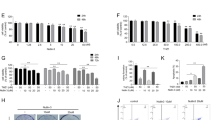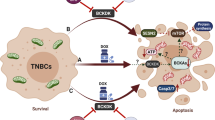Abstract
FXYD3, also known as mammary tumor protein 8, is overexpressed in several common cancers, including in many breast cancers. We examined if such overexpression might protect Na+/K+-ATPase and cancer cells against the high levels of oxidative stress characteristic of many tumors and often induced by cancer treatments. We measured FXYD3 expression, Na+/K+-ATPase activity and glutathionylation of the β1 subunit of Na+/K+-ATPase, a reversible oxidative modification that inhibits the ATPase, in MCF-7 and MDA-MB-468 cells. Expression of FXYD3 was suppressed by transfection with FXYD3 siRNA. A colorimetric end-point assay was used to estimate cell viability. Apoptosis was estimated by caspase 3/7 (DEVDase) activation using a Caspase fluorogenic substrate kit. Expression of FXYD3 in MCF-7 breast cancer cells was ~eightfold and ~twofold higher than in non-cancer MCF-10A cells and MDA-MB-468 cancer cells, respectively. A ~50 % reduction in FXYD3 expression increased glutathionylation of the β1 Na+/K+-ATPase subunit and reduced Na+/K+-ATPase activity by ~50 %, consistent with the role of FXYD3 to facilitate reversal of glutathionylation of the β1 subunit of Na+/K+-ATPase and glutathionylation-induced inhibition of Na+/K+-ATPase. Treatment of MCF-7 and MDA-MB- 468 cells with doxorubicin or γ-radiation decreased cell viability and induced apoptosis. The treatments upregulated FXYD3 expression in MCF-7 but not in MDA-MB-468 cells and suppression of FXYD3 in MCF-7 but not in MDA-MB-468 cells amplified effects of treatments on Na+/K+-ATPase activity and treatment-induced cell death and apoptosis. Overexpression of FXYD3 may be a marker of resistance to cancer treatments and a potentially important therapeutic target.







Similar content being viewed by others
References
Sweadner KJ, Rael E (2000) The FXYD gene family of small ion transport regulators or channels: cDNA sequence, protein signature sequence, and expression. Genomics 68(1):41–56. doi:10.1006/geno.2000.6274
Yamamoto H, Okumura K, Toshima S, Mukaisho K, Sugihara H, Hattori T, Kato M, Asano S (2009) FXYD3 protein involved in tumor cell proliferation is overproduced in human breast cancer tissues. Biol Pharm Bull 32(7):1148–1154
Grzmil M, Voigt S, Thelen P, Hemmerlein B, Helmke K, Burfeind P (2004) Up-regulated expression of the MAT-8 gene in prostate cancer and its siRNA-mediated inhibition of expression induces a decrease in proliferation of human prostate carcinoma cells. Int J Oncol 24(1):97–105
Kayed H, Kleeff J, Kolb A, Ketterer K, Keleg S, Felix K, Giese T, Penzel R, Zentgraf H, Buchler MW, Korc M, Friess H (2006) FXYD3 is overexpressed in pancreatic ductal adenocarcinoma and influences pancreatic cancer cell growth. Int J Cancer J 118(1):43–54. doi:10.1002/ijc.21257
Morth JP, Pedersen BP, Toustrup-Jensen MS, Sorensen TL, Petersen J, Andersen JP, Vilsen B, Nissen P (2007) Crystal structure of the sodium-potassium pump. Nature 450(7172):1043–1049. doi:10.1038/nature06419
Shinoda T, Ogawa H, Cornelius F, Toyoshima C (2009) Crystal structure of the sodium-potassium pump at 2.4 A resolution. Nature 459(7245):446–450. doi:10.1038/nature07939
Geering K (2006) FXYD proteins: new regulators of Na-K-ATPase. Am J Physiol Renal Physiol 290(2):F241–250. doi:10.1152/ajprenal.00126.2005
Bibert S, Liu CC, Figtree GA, Garcia A, Hamilton EJ, Marassi FM, Sweadner KJ, Cornelius F, Geering K, Rasmussen HH (2011) FXYD proteins reverse inhibition of the Na+-K+ pump mediated by glutathionylation of its beta1 subunit. J Biol Chem 286(21):18562–18572. doi:10.1074/jbc.M110.184101
Liu CC, Karimi Galougahi K, Weisbrod RM, Hansen T, Ravaie R, Nunez A, Liu YB, Fry N, Garcia A, Hamilton EJ, Sweadner KJ, Cohen RA, Figtree GA (2013) Oxidative inhibition of the vascular Na+-K+ pump via NADPH oxidase-dependent beta1-subunit glutathionylation: implications for angiotensin II-induced vascular dysfunction. Free Radic Biol Med 65:563–572. doi:10.1016/j.freeradbiomed.2013.06.040
Pani G, Giannoni E, Galeotti T, Chiarugi P (2009) Redox-based escape mechanism from death: the cancer lesson. Antioxid Redox Signal 11(11):2791–2806. doi:10.1089/ars.2009.2739
Mijatovic T, Dufrasne F, Kiss R (2012) Cardiotonic steroids-mediated targeting of the Na+/K+-ATPase to combat chemoresistant cancers. Curr Med Chem 19(5):627–646
Holliday DL, Speirs V (2011) Choosing the right cell line for breast cancer research. Breast Cancer Res 13(4):215. doi:10.1186/bcr2889
Pfaffl MW (2001) A new mathematical model for relative quantification in real-time RT-PCR. Nucleic Acids Res 29(9):e45
Liu CC, Gebicki JM (2012) Intracellular GSH and ascorbate inhibit radical-induced protein chain peroxidation in HL-60 cells. Free Radic Biol Med 52(2):420–426. doi:10.1016/j.freeradbiomed.2011.10.450
Saxena NK, Vertino PM, Anania FA, Sharma D (2007) leptin-induced growth stimulation of breast cancer cells involves recruitment of histone acetyltransferases and mediator complex to CYCLIN D1 promoter via activation of Stat3. J Biol Chem 282(18):13316–13325. doi:10.1074/jbc.M609798200
Nicholson DW, Thornberry NA (1997) Caspases: killer proteases. Trends Biochem Sci 22(8):299–306
Fiske CH, Subbarow Y (1925) The colorimetric determination of phosphorous. J Biol Chem 66:375–400
Figtree GA, Liu CC, Bibert S, Hamilton EJ, Garcia A, White CN, Chia KK, Cornelius F, Geering K, Rasmussen HH (2009) Reversible oxidative modification: a key mechanism of Na+-K+ pump regulation. Circ Res 105(2):185–193. doi:10.1161/CIRCRESAHA.109.199547
Yamamoto H, Mukaisho K, Sugihara H, Hattori T, Asano S (2011) Down-regulation of FXYD3 is induced by transforming growth factor-beta signaling via ZEB1/deltaEF1 in human mammary epithelial cells. Biol Pharm Bull 34(3):324–329
Grek CL, Zhang J, Manevich Y, Townsend DM, Tew KD (2013) Causes and consequences of cysteine S-glutathionylation. J Biol Chem 288(37):26497–26504. doi:10.1074/jbc.R113.461368
Cornelius F, Mahmmoud YA (2003) Functional modulation of the sodium pump: the regulatory proteins “Fixit”. News Physiol Sci 18:119–124
Fuller W, Tulloch LB, Shattock MJ, Calaghan SC, Howie J, Wypijewski KJ (2013) Regulation of the cardiac sodium pump. Cell Mol Life Sci: CMLS 70(8):1357–1380. doi:10.1007/s00018-012-1134-y
Mishra NK, Peleg Y, Cirri E, Belogus T, Lifshitz Y, Voelker DR, Apell HJ, Garty H, Karlish SJ (2011) FXYD proteins stabilize Na, K-ATPase: amplification of specific phosphatidylserine-protein interactions. J Biol Chem 286(11):9699–9712. doi:10.1074/jbc.M110.184234
Clifford RJ, Kaplan JH (2013) Human breast tumor cells are more resistant to cardiac glycoside toxicity than non-tumorigenic breast cells. PLoS One 8(12):e84306. doi:10.1371/journal.pone.0084306
Cherniavsky Lev M, Karlish SJ, Garty H (2015) Cardiac glycosides induced toxicity in human cells expressing alpha1-, alpha2-, or alpha3-isoforms of Na-K-ATPase. Am J Physiol Cell Physiol 309(2):C126–135. doi:10.1152/ajpcell.00089.2015
Maxwell PJ, Longley DB, Latif T, Boyer J, Allen W, Lynch M, McDermott U, Harkin DP, Allegra CJ, Johnston PG (2003) Identification of 5-fluorouracil-inducible target genes using cDNA microarray profiling. Cancer Res 63(15):4602–4606
Kayed H, Kleeff J, Keleg S, Jiang X, Penzel R, Giese T, Zentgraf H, Buchler MW, Korc M, Friess H (2006) Correlation of glypican-1 expression with TGF-beta, BMP, and activin receptors in pancreatic ductal adenocarcinoma. Int J Oncol 29(5):1139–1148
Trial SRC (1997) Improved survival with preoperative radiotherapy in resectable rectal cancer. N Engl J Med 336(14):980–987. doi:10.1056/NEJM199704033361402
Loftas P, Onnesjo S, Widegren E, Adell G, Kayed H, Kleeff J, Zentgraf H, Sun XF (2009) Expression of FXYD-3 is an independent prognostic factor in rectal cancer patients with preoperative radiotherapy. Int J Radiat Oncol Biol Phys 75(1):137–142. doi:10.1016/j.ijrobp.2008.10.076
Spurgers KB, Coombes KR, Meyn RE, Gold DL, Logothetis CJ, Johnson TJ, McDonnell TJ (2004) A comprehensive assessment of p53-responsive genes following adenoviral-p53 gene transfer in Bcl-2-expressing prostate cancer cells. Oncogene 23(9):1712–1723. doi:10.1038/sj.onc.1207293
Lacroix M, Toillon RA, Leclercq G (2006) p53 and breast cancer, an update. Endocr Relat Cancer 13(2):293–325. doi:10.1677/erc.1.01172
Jiang D, LaGory EL, Kenzelmann Broz D, Bieging KT, Brady CA, Link N, Abrams JM, Giaccia AJ, Attardi LD (2015) Analysis of p53 transactivation domain mutants reveals Acad11 as a metabolic target important for p53 pro-survival function. Cell Rep 10(7):1096–1109. doi:10.1016/j.celrep.2015.01.043
Nam SY, Sabapathy K (2011) p53 promotes cellular survival in a context-dependent manner by directly inducing the expression of haeme-oxygenase-1. Oncogene 30(44):4476–4486. doi:10.1038/onc.2011.150
Dishing out Cancer Treatment (2013). Nat Biotechnol 31(2):85. doi:10.1038/nbt.2516
Woolston CM, Storr SJ, Ellis IO, Morgan DA, Martin SG (2011) Expression of thioredoxin system and related peroxiredoxin proteins is associated with clinical outcome in radiotherapy treated early stage breast cancer. Radiother Oncol 100(2):308–313. doi:10.1016/j.radonc.2011.05.029
Woolston CM, Zhang L, Storr SJ, Al-Attar A, Shehata M, Ellis IO, Chan SY, Martin SG (2012) The prognostic and predictive power of redox protein expression for anthracycline-based chemotherapy response in locally advanced breast cancer. Mod Pathol 25(8):1106–1116. doi:10.1038/modpathol.2012.60
Acknowledgments
The work was supported by grants from the Heart Research Australia and Ramsay Research and Teaching Fund. HHR was supported by Heart Research Australia. CCL was supported by a DVC Research/Bridging Support Fellowship from University of Sydney.
Author information
Authors and Affiliations
Corresponding author
Ethics declarations
Conflict of Interest
The authors declare that they have no conflict of interest.
Electronic supplementary material
Below is the link to the electronic supplementary material.
Rights and permissions
About this article
Cite this article
Liu, CC., Teh, R., Mozar, C.A. et al. Silencing overexpression of FXYD3 protein in breast cancer cells amplifies effects of doxorubicin and γ-radiation on Na+/K+-ATPase and cell survival. Breast Cancer Res Treat 155, 203–213 (2016). https://doi.org/10.1007/s10549-015-3667-x
Received:
Accepted:
Published:
Issue Date:
DOI: https://doi.org/10.1007/s10549-015-3667-x




